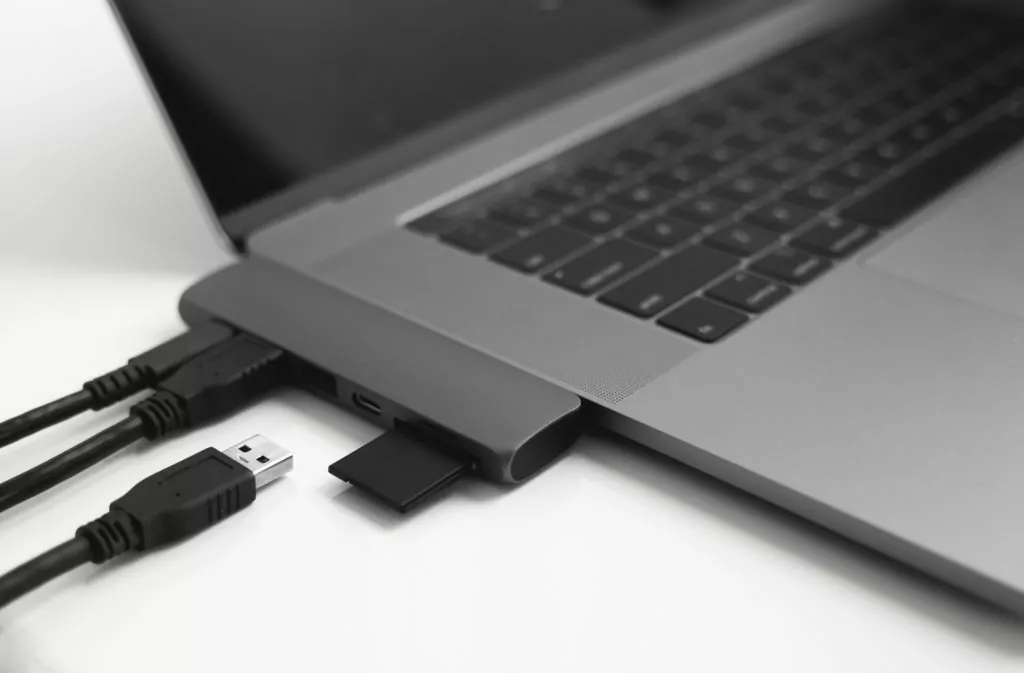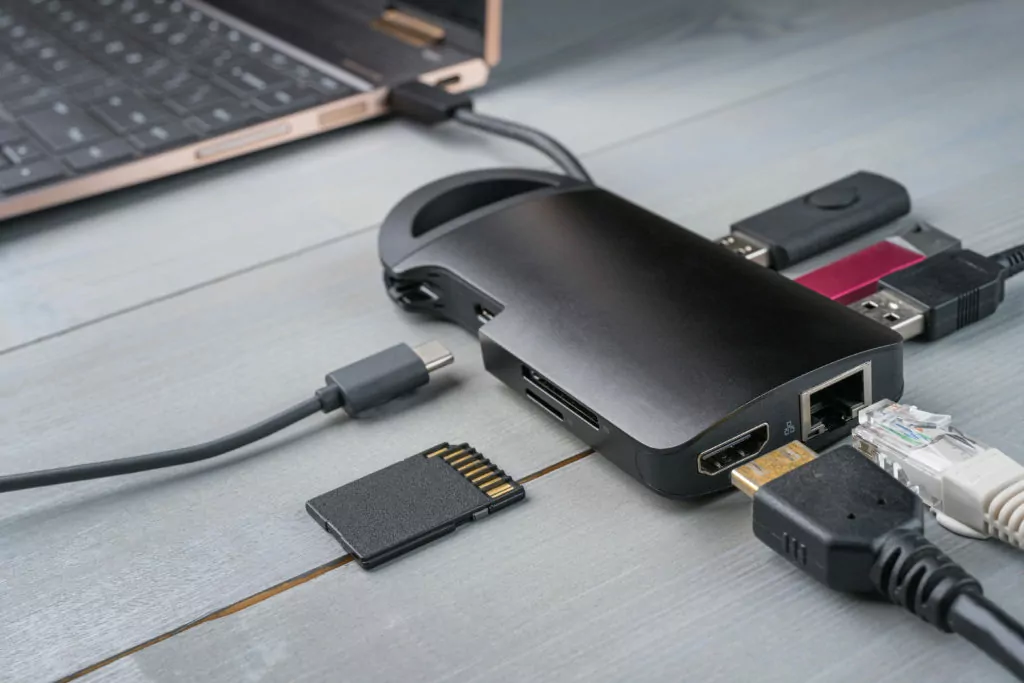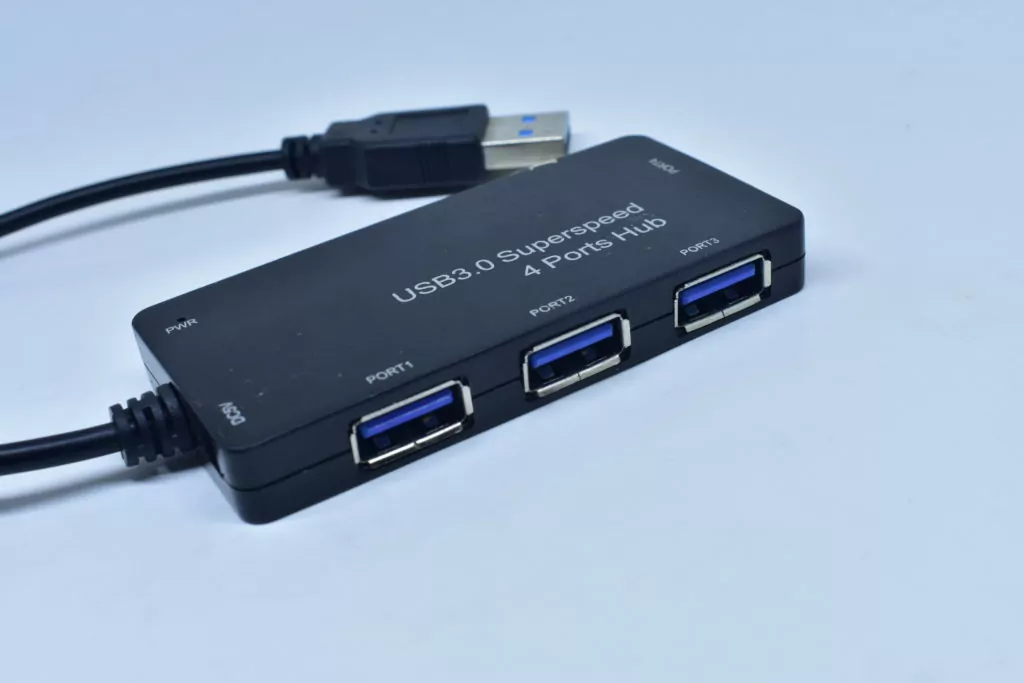Here’s why laptop docking stations are so expensive:
The price of a laptop docking station is mostly going to depend on the range of features available and the overall quality of the device.
Compared to simple USB hubs, docking stations provide more support for the laptop and cost more to make.
Still, docking stations can range from tens to thousands of dollars.
So if you want to learn all about why docking stations are so expensive, then you’re in the right place.
Let’s get started!

What Is a Laptop Docking Station?

A docking station is a device that is designed to expand the accessories and peripherals that can attach to a laptop computer.
They come in many shapes and sizes.
But in general, they are meant to stay on a desk or workspace so that you can simply plug the laptop into the station when you want to take advantage of it.
Docking stations can help you attach:
- Extra monitors
- A mouse
- An external keyboard
- An external hard drive
- External cooling fans
- Speakers
- So much more
They can also handle power distribution, so all of those things are not putting strain on the laptop battery.
What Goes Into Laptop Docking Station Pricing?

We can all appreciate the convenience that is a laptop computer.
Laptops are designed to be portable, and, as the name suggests, you can work on them pretty much anywhere (including on your lap).
Compared to desktops, laptops are smaller and lighter and they use less power.
They can be used in the airport, at a coffee shop, at your relative’s home or in a vehicle, or on a train.
They are quickly becoming the best option for students on the run, and as more and more professionals are working remotely, many companies are making the switch to laptops over desktops.
While the flexibility and compact travel size of laptops are beneficial, there are still limitations, and this is where docking stations come into play.
As with anything in the world of technology, docking stations can range in price—in this case, from $30 to $50 all the way into the multiple hundreds and thousands.
In general, docking stations tend to fall into the “you get what you pay for” category just as much as the next product on the market.
But it’s also about what you want and need in a docking station setup.
The major factors in the price point are the range of accessories managed by the docking station and the quality of the device itself.
In a general sense, cheaper docking stations usually offer fewer options and don’t last as long.
If you want a station that supports VGA, HDMI, and DisplayPort, all at the same time, it’s going to cost more than a simpler station with a single HDMI connector.
That’s just one way that the variance in attachments and options can affect pricing.
Proprietary Designs
Another reason many docking stations are so pricey is that they are often made by laptop manufacturers.
If you want to use a docking station with your HP laptop, you’ll probably take a close look at HP docking stations.
In many cases, manufacturers use proprietary connectors or attachments.
These design features make it so that third parties cannot produce comparable docking stations.
This creates exclusivity for the brands and drives down competition.
In other words, the price goes up because you can’t always get third-party docking stations.
While this might be frustrating to read, pure economics is a bit more complicated.
Generally speaking, PC computers are sold at very low-profit margins.
The numbers fluctuate with the market, but many laptop computers have been sold at a profit margin of around five percent.
For a $500 laptop, that’s a profit of only $25.
Most of the money made by these manufacturers comes from everything else.
Proprietary software, peripherals, and things like docking stations can be sold at higher margins.
In a way, the higher prices of the docking stations help to supplement the cost of the laptop itself.
Why Are Laptop Docking Stations Popular?

In our ever-changing world of technology (and just ever-changing life in general), many computer users do not want both a laptop and a desktop.
Nor do they need both a laptop and a desktop.
This is not most people’s first rodeo, and they understand the value of one type of device over the other and how it relates to their day-to-day needs, schedule, and personal vs. professional usage.
And thus, they have made a purchase accordingly.
Those with desktops have a super cool area that is designated for their computer setup (probably with a specialty mousepad and coffee mug full of pens), but they know they cannot take their monitor and modem in the car with them to work.
Those with laptops understand that they do not have the largest screen or keyboard.
If they really want a specialized mouse and a bunch of extensions on the device, there just isn’t enough room to plug it all in and make it all work.
Unless, of course, you use add-on peripherals like a docking station.
Yes, thanks to docking stations, laptop users can get the best of both worlds without having to buy a desktop in addition to their laptop.
They still have a portable computer when they need it, but their laptop can be a part of a more stationary setup with a docking station.
Features that are not traditionally a part of a standard laptop due to size and space limitations are now available when a laptop is connected to a docking station.
And frustrations like not being able to view twelve webpage windows while also editing your manager’s 10-tab Excel document on a 13-in laptop screen are alleviated when that docking station provides you the advantage to hook up to a full-screen monitor (or two… or three).
So, What’s the Deal With Laptop Docking Stations and Their Expensiveness?

We’ve established that docking stations allow users to transform their laptops into powerful workstations.
You simply connect your laptop computer to the docking station, and it expands to a desktop configuration.
Then you disconnect it, and you have a laptop again that you can place in a backpack or briefcase (or just hold it) and take to your next meeting (or the couch).
As the years have gone by, we’ve seen laptops getting smaller, thinner, and lighter.
Newer laptops, whether Apple Macs or Windows PCs are boasting sleek designs, but the number of ports available is becoming slimmer and slimmer.
Most laptops still have at minimum a power port for your charger, a headphone port (headphones may or may not be included in your laptop purchase), and some type of additional port connection like a USB-A/B/C or, for Mac users, extra Thunderbolt ports.
Many times, laptop users need to purchase additional cords and adapters to connect their laptop to accessories like a mouse, printer, larger monitor screen, or even a digital camera.
Docking stations help users deal with the smaller, thinner, and lighter laptop ramifications by giving back all the features that were lost when people gave up their desktops in return for the laptop’s convenience.
Or rather, they just fix the issues.
Docking stations are physical pieces of technology that need to have a home.
Typically, users have a desk or table in a designated office, room, or area of their house or office building where they go to work.
This can work like a standard 9 am to 5 pm on-the-clock job, hours of photo editing before you post everything on social media, or “this is my zone and where I design and work on my budget sheets for all the cool things for my Jeep hobby that I should probably make into a business” work.
It does not matter what you do or if you have a setup for work or play— all sorts of people and their computer uses benefit from docking stations.
A docking station simply sits on a desk whether or not your laptop is there, and you connect things to it.
And you can then connect MORE things to it.
Some docking stations are smaller and connect to the back or bottom of your laptop, and then you start adding accessories.
Other docking stations are a lot larger and more complex.
They add height or even hide your laptop completely to the point where you think you actually have a desktop instead.
Some highlights of docking stations include, but are not limited to the following:
- Allowing Mac users with Thunderbolt ports to have access to standard USB ports and thus greatly expanding the accessories available to their laptop
- Allowing PC users with USB ports to have access to MORE USB ports
- Plugging in a mouse with a cord from an old desktop or having an extra USB for a wireless mouse instead of using a laptop’s sometimes finicky trackpad or touchpad
- Plugging in a larger, standard keyboard with a cord from an old desktop instead of using a laptop’s more compact keyboard
- Plugging in a printer/scanner instead of accessing it wirelessly which can often times cause queuing issues or take longer to get physical documents needed
- Plugging in an SD memory card from a digital camera or connecting your digital camera directly to the station via the original cord vs. an adapter
- Connecting to a larger monitor setup for viewing ease
- Connecting to a multiple monitor setup for maximum efficiency and multitasking productivity
- Creating a cleaner working station by routing cables and cords to the back of the station, thus allowing for even more space to work or spread out on a desk or table
- Enabling easier ethernet connection in the case of WIFI malfunction or connectivity issues
- Purchasing options include a variety of designs and colors if you want to get fancy or if you need to match something
- Compatibility with power supplies that eliminate the need for multiple chargers (meaning you can charge your cell phone and keep your laptop at 100% battery)
- Flexibility in being used and can fit easily in most spaces and setups whether sitting or using the popular standing desk option
- Transforming a video gamer’s experience by using a monitor with higher resolution than is possible on their laptop alone
You can get individual cables and adapters to do any one of those things, but a docking station can do all of it in a single device, and it can manage power distribution for the whole setup.
That’s primarily what raises the price.
How Would You Compare Laptop Docking Stations vs. Hubs?

While docking stations provide a huge package of options and flexibility, they might be overkill for some users.
You really need to think through what you need and what you are wanting to use with your laptop.
If you do not need a higher-level, higher-functioning laptop environment that’s stationary and are just looking for 1 or 2 more additional ports, you might want to look into a simple hub option.
Hubs are smaller devices that simply expand the number of ports for your device.
They typically have a USB cord connection on one end and are small devices with a row of ports down the center.
You connect the USB cord to your laptop, and then you connect whatever accessories you want into the row of ports.
Some hubs only have 2-3 extra ports available, and they are only USB ports.
Other hubs have 10+ ports available and range from USB and HDMI to SD memory card and ethernet.
Some hubs only have one extra port, and you can just buy an option only to use that camera that still has an SD memory card.
Hubs are smaller devices that simply expand the number of ports for your device.
They typically have a USB cord connection on one end and are small devices with a row of ports down the center.
You connect the USB cord to your laptop, and then you connect whatever accessories you want into the row of ports.
Some hubs only have 2-3 extra ports available, and they are only USB ports.
Other hubs have 10+ ports available and range from USB and HDMI to SD memory cards and ethernet.
Some hubs only have one extra port, and you can just buy an option only to use that camera that still has an SD memory card.
Hubs have been described as “power strips for your laptop” or are the “little brothers of docking stations,” and that’s a good way to think about it.
Alternative Setups
While docking stations are a fantastic way to simplify the solution for a laptop user who needs a grander computer experience, the jury is still out regarding if they are really necessary.
Humans are amazing at creating systems and setups that are non-standard and excel in the realm of creativity.
For example, say you are an employee who is now working from home.
You have a work laptop that’s a PC, and you’ve now decided you would really like a dual monitor display for your home office.
You have a laptop with USB ports.
You look in your closet and realize you have an extra desktop monitor, and you have a desk.
You rummage through your junk drawer and also find you have a beautiful HDMI to USB cable.
You’re in business to set up that second monitor for your laptop right now.
No hub is needed, and no docking station is needed for two-screen capability.
Now, you might need to adjust a few viewing settings on external display mode on your laptop for multiple display areas and resolutions, but that’s a pretty small price to pay for increasing your visual experience.
There are converters and adapters galore floating around this great wide world of ours, as well as a ton of DIY home office ideas that don’t include docking stations.
However, sometimes having everything in one place and connected within one system has its advantages.
This really drives home the purpose behind docking stations.
They simplify your setup so that you aren’t tracking down individual converters, cables, and the rest in order to create a workspace that lives up to your specific needs.
Why Is Microsoft Office So Expensive?

So now you know why docking stations are as expensive as they are.
On another note, how come Microsoft Office seems to have such a steep price?
Microsoft sets its current price points for Office primarily to make money.
They invest heavily in developing Office software, and they want to make a profit.
Having said that, the price of Office varies widely depending on your license, and it isn’t always expensive.
Learn all about whether Microsoft is as expensive as it appears here.

